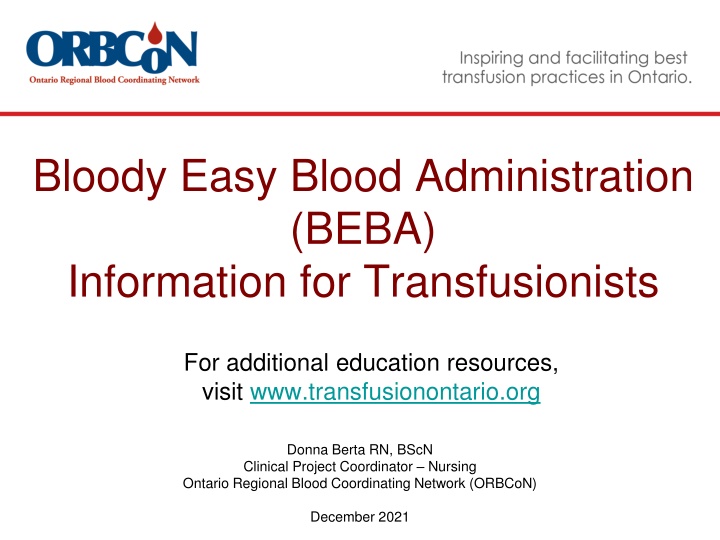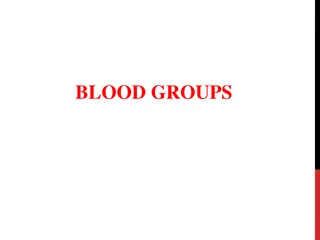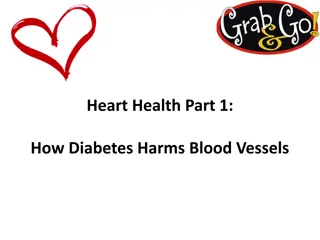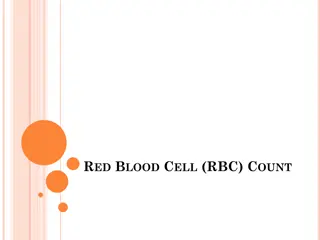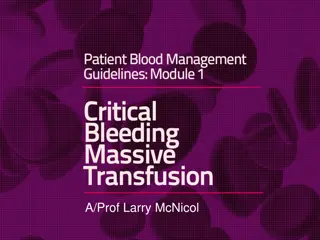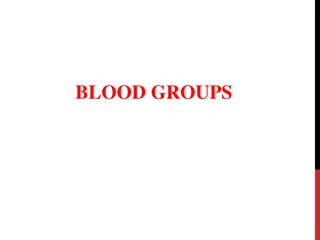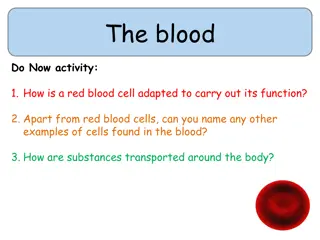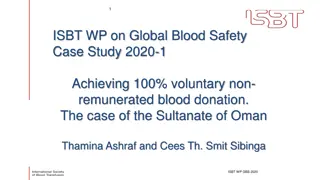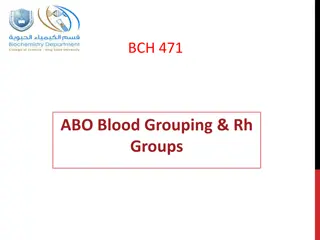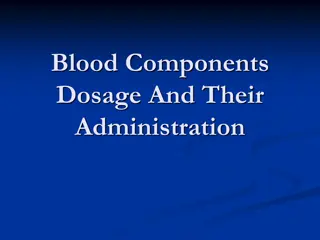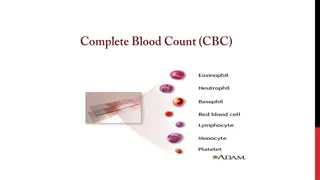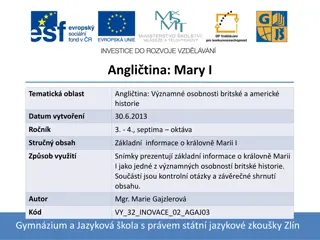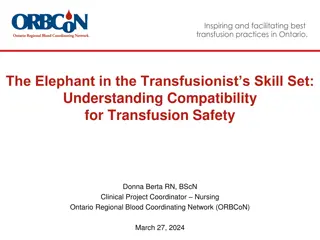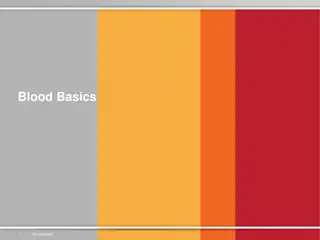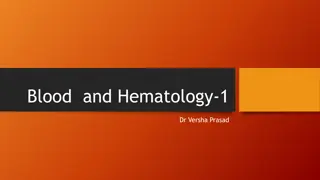Bloody Easy Blood Administration (BEBA) Guidelines for Transfusionists
This comprehensive guide provides transfusionists with essential information on blood administration, including transfusion guidelines for RBC, platelet, and plasma, actions for safe administration, and immediate management of transfusion reactions. It covers indications, doses, and details for adult patients, along with resources for additional learning. Be equipped to ensure safe and effective blood transfusions by understanding the protocols outlined in this educational material.
Download Presentation

Please find below an Image/Link to download the presentation.
The content on the website is provided AS IS for your information and personal use only. It may not be sold, licensed, or shared on other websites without obtaining consent from the author.If you encounter any issues during the download, it is possible that the publisher has removed the file from their server.
You are allowed to download the files provided on this website for personal or commercial use, subject to the condition that they are used lawfully. All files are the property of their respective owners.
The content on the website is provided AS IS for your information and personal use only. It may not be sold, licensed, or shared on other websites without obtaining consent from the author.
E N D
Presentation Transcript
Bloody Easy Blood Administration (BEBA) Information for Transfusionists For additional education resources, visit www.transfusionontario.org Donna Berta RN, BScN Clinical Project Coordinator Nursing Ontario Regional Blood Coordinating Network (ORBCoN) December 2021
Objectives After completing this learning participants will be able to: Explain the transfusion guidelines (indications, dose, and details) for RBC, platelet and plasma transfusion in adult patients. Describe the transfusionist s actions to ensure safe transfusion administration. Identify signs and symptoms and immediate management actions of a possible transfusion reaction. Consult your hospital s policies and procedures for additional details specific to your facility. Links to supplementary information Summary: Transfusion Checklist (refer to slide 42) Glossary of Terms & Abbreviations (refer to slides 43-45) 2
Objectives/Outline After completing this learning participants will be able to: Explain the transfusion guidelines (indications, dose, and details) for RBC, platelet and plasma transfusion in adult patients. Outline: Topic: RBC Transfusion Indications Dose & Details Platelet Transfusion Indications Dose & Details Plasma Transfusion Indications Dose & Details Transfusion Guidelines Refer to slide number: 4 5 6 7 8 9 3
Transfusion Guidelines: RBC Transfusion - Indications Rationale: Red blood cells transport oxygen from the lungs to the tissue cells. Oxygen is needed for tissue cells to carry out their functions in the body. Adults, not actively bleeding, consider if: Hb less than 70 g/L With evidence of impaired tissue oxygen delivery (tachycardia, hypotension, cardiac ischemia, syncope, pre-syncope) o Hb 70 to 80 g/L o Some specific patients, Hb 80 to 90 g/L Note: Do not transfuse based on only a Hb value. Patient clinical assessment is required. RBC transfusion is indicated for symptomatic anemia. About Blood Production, BEBA Handbook, pages 6-7 4
Transfusion Guidelines: RBC Transfusion - Dose & Details Adults, not actively bleeding: 1 unit Volume = about 300 mL RBC shelf-life: 42 days, Stored at 1-6 C in approved, monitored refrigerator Transfuse over 2 hours, slower if Transfusion Associated Circulatory Overload (TACO) risk If urgent Hb re-assessment required, test Hb 15 minutes after RBC is transfused 1 unit = about 10 g/L Hb increase Consider a 2nd unit only if re-assessment (patient s clinical status, Hb result) indicates need Canadian Blood Services, Circular o f Information [Scroll down, click on Red Blood Cells, Leukocytes Reduced (LR)] 5
Transfusion Guidelines: Platelet Transfusion - Indications Rationale: Platelets are the first responders in the clotting process to stop bleeding (sticky cells, form the platelet plug). 6
Transfusion Guidelines: Platelet Transfusion - Dose & Details Adults: 1 dose (Pooled or Apheresis), minimum platelet count is 240 x109/dose (mean approximately 330 x109/dose) Volume: Pooled - mean 317 mL Apheresis - mean 223 mL Platelets shelf-life: 7 days, stored at 20-24 C on an approved, monitored agitator Transfuse over 60 minutes, slower if TACO risk If pre-procedure, transfuse just prior to procedure Re-check platelet count 10 to 60 minutes after platelet is transfused 1 dose = 15-25 x109/L increase in platelet count at 10 to 60 minutes post transfusion Canadian Blood Services, Circular of Information [Scroll down, click on Pooled Platelets LR, CPD, Apheresis Platelets] 7
Transfusion Guidelines: Plasma Transfusion - Indications Rationale: Plasma contains all the coagulation factors necessary for the clotting process to stop bleeding. Adults, consider if: Active bleeding or prior to major procedure*/surgery, and patient** with INR 1.8 due to multiple coagulation factor deficiency (if no coagulation factor concentrates or alternatives available). * Radiology procedures (major) with bleeding risk include: lumbar puncture or spinal procedure with hematoma risk, arterial intervention, biliary tract intervention or TIPS procedure, deep abscess drainage, urinary tract intervention, solid organ biopsy. ** Liver disease patients: the liver synthesizes all coagulation factors (procoagulant and anticoagulant); hemostatic pathways are rebalanced; often correction of abnormal INR is not needed before a procedure. Note: Plasma should not be used for urgent reversal of warfarin unless prothrombin complex concentrate (PCC) is unavailable or contraindicated (history of heparin-induced thrombocytopenia). 8
Transfusion Guidelines: Plasma Transfusion - Dose & Details Adults 10 to 15 mL/kg; Ordered in units: Small adult - 3 units, Large adult - 4 units Volume: o 1 unit = about 250 mL [Frozen plasma (FP), Apheresis fresh frozen plasma (AFFP)] o some double or 2 units = about 500 mL (AFFP) Plasma shelf-life: up to 1 year, stored frozen at minus 18 C in approved, monitored freezer Thawing plasma requires about 30 minutes of time Transfuse each unit over 30 minutes to 2 hours, slower if TACO risk 1 dose increases coagulation factors about 20 % for about 6 hours As indicated, check INR, PTT 10 to 60 minutes post-transfusion Note: Thawed 250 mL plasma can be stored refrigerated in TML for up to 5 days (120 hours) Thawed 500 mL plasma can be stored refrigerated in TML for up to 24 hours Canadian Blood Services, Circular of Information [Scroll down, click on Plasma Components] 9
Objectives/Outline After completing this learning participants will be able to: Describe the transfusionist s actions to ensure safe transfusion administration. Outline: Pre-Transfusion Topic: Transfusion Order Informed Consent Group & Screen The Test: ABO & Rh(D) Group and Antibody Screen Using Test Results/Compatibility Sample Collection Preparing the Patient TACO (Transfusion Associated Circulatory Overload) IV Access/Fluids/Medications/Infusion Devices Tubing/Filter Picking Up Blood Refer to slide number: 10 11 13-20 13-17 18-19 20 21 22 23 24 25 10
Pre-transfusion: Transfusion Order Transfusionist must ensure: Indication for transfusion (patient signs & symptoms, laboratory test results) and dose align with transfusion guidelines Knowledge of component/product specific administration details Administration: Blood Components/some Blood Products, BEBA Handbook, pages 98-117 Order must include: Patient s surname, first name and unique identification number & Date to be given Blood component/blood product & Number of units/doses Rate or duration of infusion, e.g. 150 mL/hour or over 2 hours (or per hospital standard protocol) Medication orders, if any (premedication or diuretic) Special modifications or requirements, if any (washed/irradiated) Blood warmer/rapid infusion device, if needed (or per hospital protocol) Sequence for transfusion of multiple components/products 11
Pre-transfusion: Informed Consent Required for blood transfusion Obtained by health care professional prescribing the transfusion Valid for the current course of treatment or hospital admission Note: In emergency situations with life or health threatening bleeding, prescriber may declare that transfusion proceed without informed consent Transfusionist role: Confirm hospital policy/procedure has been fulfilled prior to transfusion If informed consent has not been completed for a non-emergency transfusion, do not transfuse, advise the prescriber Advocate for patient; Facilitate the informed consent process Information to engage in patient dialogue For complete transfusion risk details, BEBA Handbook, pages 118-119 12
Pre-transfusion: Group & Screen ABO Blood Groups A current group & screen test is essential for transfusion of compatible blood components (incompatible [antigen/antibody] transfusion can lead to life-threatening, acute hemolysis). Group: ABO blood groups Test patient sample: presence or absence of A and B antigens on the red blood cells presence or absence of anti-A and anti-B antibodies in the plasma GROUP AB GROUP A In the ABO system, antibodies are naturally acquired, starting at 4 months of age. If the antigen is present on the surface of the red blood cells, then the corresponding antibody will NOT be in the plasma. If the antigen is NOT present on the surface of the red blood cells, then the corresponding antibody will be in the plasma. GROUP B GROUP O 13
Pre-transfusion: Group & Screen Rh(D) Blood Groups A current group & screen test is essential for transfusion of compatible blood components (incompatible [antigen/antibody] transfusion can lead to life-threatening, acute hemolysis). Group: Rh(D) blood group Test patient sample: presence or absence of D antigen on the red blood cells GROUP Rh(D) POSITIVE GROUP Rh(D) NEGATIVE Rh(D) Blood Group: Anti-D Antibody In the Rh(D) system, anti-D antibody is NOT naturally occurring and is NOT in the plasma of: o Rh(D) positive patients o Rh(D) negative patients UNLESS exposed to the D antigen and then anti-D may be produced Rh(D) negative individuals can be exposed to the D antigen (and then may produce anti-D) through: o Transfusion of Rh(D) positive RBC o Transfusion of Rh(D) positive platelets (platelets may contain small amounts of red blood cells) o Pregnancy/delivery of an Rh(D) positive fetus 14
Pre-transfusion: Group & Screen Antibody Screen (1) A current group & screen test is essential for transfusion of compatible blood components (incompatible [antigen/antibody] transfusion can lead to life-threatening, acute hemolysis). Screen: Antibody Screen In addition to antigens A & B, human red blood cells have many antigens If exposed to foreign red blood cell antigens via pregnancy or transfusion, antibodies against these antigens may develop Some antibodies are clinically significant; they can cause life-threatening acute hemolysis (break down or destruction) of red blood cells that have the corresponding antigen Antibodies formed against the antigens on this red blood cell are clinically significant 15
Pre-transfusion: Group & Screen Antibody Screen (2) A current group & screen test is essential for transfusion of compatible blood components (incompatible [antigen/antibody] transfusion can lead to life-threatening, acute hemolysis). Screen: Antibody Screen TML tests the serum (plasma part of blood sample) to rule out or to identify any of the clinically significant antibodies If all clinically significant antibodies are ruled out, the antibody screen is reported as negative If clinically significant antibody(ies) are identified, then compatible RBC units for transfusion to that patient must be negative for the corresponding antigen(s) (e.g., anti-c and anti-Jkaidentified in patient s blood sample, then RBC units for transfusion must be antigens c- and Jka-) TML uses the patient s Group & Screen test results to select compatible blood components for transfusion to that patient. Group & Screen BEBA Handbook, pages 20-25 16
Pre-transfusion: Group & Screen Group: Summary A current group & screen test is essential for transfusion of compatible blood components (incompatible [antigen/antibody] transfusion can lead to life-threatening, acute hemolysis). 17
Pre-transfusion: Group & Screen Using Test Results/Compatibility (1) TML uses the patient s Group & Screen test results to select compatible blood components for transfusion to that patient, guided by ABO & Rh(D) compatibility table. 18
Pre-transfusion: Group & Screen Using Test Results/Compatibility (2) RBC Transfusion: Must be crossmatched (after group & screen test, TML procedure to detect any incompatibility between donor RBC unit & patient) Donor RBC unit must be ABO & Rh(D) identical or compatible to patient If patient s antibody screen identified clinically significant antibody(ies), then donor RBC unit must be corresponding antigen negative Platelet Transfusion: Donor platelet dose ideally is ABO & Rh(D) identical to patient Should be ABO plasma compatible (i.e., compatible with the patient s red blood cells as donor platelets are suspended in plasma) If in short supply (occurs often), TML follows policy re: ABO group substitution; ABO plasma incompatible platelets may be transfused Plasma Transfusion: Donor plasma unit ABO identical or compatible to patient Rh(D) blood group is not relevant for plasma transfusion (plasma has no red blood cells [i.e., no antigens]) Blood Products (Plasma Protein Products) ABO and Rh(D) blood group compatibility is not relevant (blood products are manufactured in lots, from plasma combined from many donors of diverse ABO blood groups). 19
Pre-transfusion: Group & Screen Sample Collection Meticulous attention to sample collection procedure is essential for patient safety! Step 1: Step 2: Step 3: In the presence of the patient, confirm patient s surname, first name and unique identification number on the patient s armband and the sample label are identical. Some hospitals use bar- code scanning (positive patient identification) systems. Immediately after collecting the blood sample, place the label on the tube of blood at the patient s bedside. Labelling a sample away from the patient greatly increases risk of mislabelling. Document that you collected the sample. You are documenting your accountability for unequivocal (unmistakable) patient identification. Note: If patient was transfused or pregnant within the preceding 3 months (or if unknown), the blood sample for crossmatching RBC units must be collected within 96 hours prior to transfusion (ensures patient has not formed any new antibodies related to recent transfusion or pregnancy). Note: To issue non-group O, ABO compatible RBC, TML requires two separate blood group determinations One determination must be from current blood sample Second determination: from historical record if previous test completed, or a separate sample collection, or if sample collection using bar-code scanning, re-test current sample. 20
Pre-transfusion: Preparing the Patient Patient must be wearing a patient identification armband. Educate the patient about what to expect during transfusion (i.e., periodic assessments, vital sign checks, symptoms indicative of a transfusion reaction). Assess if history of previous transfusions. If so, assess if special requirements, or antibody card, or transfusion reactions. If indicated, follow up with prescriber and/or TML. Evaluate each transfusion for each patient for Transfusion Associated Circulatory Overload (TACO) risk factors. If indicated, follow up with prescriber for prevention strategies. 21
Pre-transfusion: Transfusion Associated Circulatory Overload (TACO) Leading cause of transfusion related deaths; PREVENTION is imperative Occurs secondary to transfusion at a rapid rate and/or the specific patient s cardiac capacity is unable to tolerate transfusion volume. Signs: acute/worsening respiratory distress, decreased oxygen saturation, tachycardia, increased blood pressure, acute pulmonary edema TACO Risk Factors Advanced age History of heart failure History of myocardial infarction Left ventricular dysfunction Renal dysfunction Positive fluid balance TACO Prevention Strategies Transfuse only 1 unit at a time Transfuse slowly over longer time period (maximum 4 hours) Pre-transfusiondiuretic (PO 30 minutes prior; IV just prior) TML to divide unit (if equipment available, then transfuse each part over maximum 4 hours) If risk, review with prescriber for prevention strategies 22
Pre-transfusion: IV Access/Fluids/Medications/Infusion Devices IV Access Confirm IV patent; Dedicated site - peripheral or central venous (if multiple lumen central line, a specific lumen for only the blood) Adult transfusion IV gauge: Routine - 20 to 22; Rapid - 14 to 18 IV Fluids Blood is compatible with only 0.9% sodium chloride (Exception IVIG, some brands are compatible with only 5% Dextrose in water; refer to brand specific product monograph). IV Medications Do not infuse any medication concurrently with blood (all medications are incompatible). If a medication must be given during transfusion, flush IV site with 0.9% sodium chloride flush syringes pre and post medication administration. Infusion Devices Use only if device is Health Canada Medical Device Regulations approved. To transfuse blood (RBC, platelets, plasma, IVIG etc.), an infusion pump may be used. If ordered, blood warmers and rapid infusers can be used for RBC and plasma transfusion. Note: Hemolysis can occur with RBC transfusion if: IV gauge too small, IV solutions other than 0.9 % sodium chloride used, improper storage leading to inadvertent heating or freezing, and infusion device malfunctions. 23
Pre-transfusion: Tubing/Filter RBC, platelets and plasma must be transfused via blood tubing with 170 - 260 micron filter (captures any fibrin debris). Platelet transfusion: Always use NEW/FRESH blood tubing/filter (If filter was previously used, the platelets will adhere to fibrin captured in the filter; platelets are sticky!). Prime with blood or 0.9% sodium chloride Change after a maximum of 4 units of blood or 4 hours of time Be prepared for a potential transfusion reaction. Set up IV tubing such that if the transfusion must be stopped abruptly, then IV access can be maintained: o 0.9% sodium chloride flush syringes and an IV line with any IV solution are on hand, ready to infuse TKVO OR o 0.9% sodium chloride IV line is on hand, ready to infuse TKVO 24
Pre-transfusion: Picking Up Blood For patient safety, ensure all pre-transfusion preparation steps have been completed before picking up blood from TML RBC, platelets, and plasma transfusion must be completed within 4 hours of issue from TML (i.e., removal from temperature controlled environment). NEVER store blood in medication or patient care area refrigerators (temperature is not regulated) TML requires documentation of patient identification (surname, first name and unique identification number) to issue blood to patient care area. Many hospitals have a form (e.g., pick up slip) which includes the required information 25
Objectives/Outline After completing this learning participants will be able to: Describe the transfusionist s actions to ensure safe transfusion administration. Outline: Administering Transfusion Topic: Emergency Transfusion Checking Blood Patient Identification ABO, Rh(D) Blood Groups Unit number/Lot number Expiry & Visual Inspection Assessments & Vital Signs Rate of Infusion Completing Transfusion Documentation Refer to slide number: 27 28-34 29 30-32 33 34 35 36 37 38 26
Administering Transfusion: Emergency Transfusion: Uncrossmatched Blood If uncrossmatched blood is transfused, prescriber must document that clinical situation justifies transfusion. Compatibility testing (group and screen, crossmatch) should be completed ASAP, and blood components of the appropriate group issued. Platelets: never refrigerate or place in a transport cooler Massive Hemorrhage Protocol BEBA Handbook, pages 48-56, 122-123 27
Administering Transfusion: Checking Blood Unequivocal (unmistakeable) identification of the patient is mandatory. Patient must be wearing a patient identification armband. Patient identification information must remain attached to blood during transfusion. For safety, at the bedside in the presence of the patient, follow 4 steps 1. Patient Identification 2. ABO, Rh(D) Blood Groups 3. Unit number/Lot number 4. Expiry & Visual Inspection Checking Blood BEBA Handbook, pages 34-39 28
Administering Transfusion: Checking Blood 1. Patient Identification Check surname, first name, unique identification number are identical on armband, transfusion order, transfusion label & chart label/issue form 29
Administering Transfusion: Checking Blood 2. ABO, Rh(D) Blood Groups Check ABO, Rh(D) Blood Groups (only for blood components, not relevant for blood products) are identical/compatible on Group & screen test, CBS label, transfusion label & chart label/issue form 30
Administering Transfusion: Checking Blood - ABO, Rh(D) Identical/Compatible In this example the patient and blood component ABO and Rh(D) blood groups are identical. If the ABO and Rh(D) blood groups are not identical, then check the Compatibility Chart to confirm blood component ABO/Rh(D) blood groups are compatible with the patient's ABO and Rh(D) blood groups. 31
Administering Transfusion: Checking Blood - Patient Special Requirements TML provides blood as available per inventory and transfusion urgency. If transfusion will be delayed or if not available, then TML advises prescriber Antigen Negative RBC: If group & screen K Negative RBC: If patient female, age 45 years and under with childbearing potential, then confirm on CBS label the RBC unit is antigen K- (unless patient is known K positive) Rationale: to prevent anti-K antibody in females who may become pregnant; Anti-K antibody in the mother could cross the placenta and hemolyse the red blood cells of an antigen K positive fetus leading to Hemolytic Disease of the Fetus and Newborn Irradiated RBC or Platelet: If patient requires irradiated blood, then confirm CBS irradiated label is on blood bag identified clinically significant antibody, then confirm on CBS label the RBC unit is antigen negative e.g., patient has anti-Jka, RBC unit: antigen Jka- Irradiated Blood BEBA Handbook, pages 37, 78-79 Note In this example, the patient is female, age 22 years, and should receive antigen K- RBC transfusion. Review the lower right hand section of the CBS label; the unit is K-. 32
Administering Transfusion: Checking Blood 3. Unit Number/Lot Number Check the Unit number (blood components)/Lot number (blood products) are identical on CBS label (blood components)/manufacturer label (blood products), transfusion label & chart label/issue form 33
Administering Transfusion: Checking Blood 4. Expiry & Visual Inspection Expiry Check time of issue (removal from temperature controlled environment) on chart label/issue form Blood expires 4 hours from time of issue, transfusion must be completed or any remainder discarded Note: In this example, the issue time is 1420 hours 26/05/21. The RBC unit expires 4 hours later at 1820 hours 26/05/21. By 1820 hours the transfusion must be completed or any remainder discarded. Visual Inspection Check the blood bag for Any clots Unusual colour Ports are intact, no leaking Click to review the CBS Visual Assessment Guide 34
Administering Transfusion: Assessments & Vital Signs Baseline assessment: recent fevers, rashes, oxygen required, laboured respiration, chest auscultation if TACO risk Vital signs parameters: temperature, blood pressure, pulse, respiratory rate, oxygen saturation Minimum frequency (Hospital specific policy details regarding patient assessment & vital signs may be more extensive) o Baseline within 30 minutes prior to starting transfusion o 15 minutes after start of transfusion o After transfusion is completed o Periodically post-transfusion (reactions may occur up to 4 hours after transfusion; for dyspnea reactions, up to 24 hours after transfusion) o If a transfusion reaction is suspected 35
Administering Transfusion: Rate of Infusion If patient s clinical status permits (i.e., patient stable, not bleeding; transfusion not urgent) initiate blood component transfusion cautiously and slowly. Adults: for the first 15 minutes, suggested rate is 50 mL/hour Assess patient and re-check vital signs after 15 minutes If no signs/symptoms of transfusion reaction, increase to rate ordered (slower if TACO risk; maximum is 4 hours from time of issue from TML). Usual rate per unit: RBC over 2 hours Platelets over 60 minutes Plasma over 30 minutes to 2 hours Note: If blood tubing was primed with 0.9% sodium chloride, then re-prime tubing with blood component to ensure initial slow infusion rate is actually infusing blood component (blood tubing volume is 12-15 mL). 36
Administering Transfusion: Completing Transfusion Comply with expiry time specific to blood component/blood product being transfused Expiry for Blood Components: within 4 hours of time issued from TML (removal from the temperature controlled environment) Outside expiry time, discard any remainder Flush blood tubing with 0.9% sodium chloride Re-assess patient and vital signs Disconnect blood tubing when transfusion is completed (tubing can harbour bacteria) Hospital may require returning the empty blood bag to TML, otherwise dispose in biohazardous waste 37
Administering Transfusion: Documentation File completed chart label/issue form (includes documentation mandated per Transfusion Medicine standards) for each component or product transfused on patient s health record. Transfusionist must complete chart label/issue form by adding: o Start and finish date/time (confirms transfusion completed within expiry time; provides time reference point, if transfusion reaction) o Their identity Document patient care: assessments, vital signs, volume on intake/output record If a transfusion reaction is suspected, document signs/symptoms, patient care Hospital policy may require completed transfusion record be returned to TML 38
Objectives/Outline After completing this learning participants will be able to: Identify signs and symptoms and immediate management actions of a possible transfusion reaction. Outline: Topic: Signs & Symptoms Immediate Actions Transfusion Reactions Refer to slide number: 40 41 39
Transfusion Reactions: Signs & Symptoms Reactions can be categorized by key signs & symptoms: o Fever o Urticaria (hives) o Dyspnea o Hypotension Additional signs & symptoms include: Airway or Facial Edema, Anxiety, Coughing, Diffuse bleeding/oozing, Hemoglobinuria, Hypertension, Itching, Nausea/Vomiting, Pain (Back, Headache, IV site), Rash, Shaking Chills/Rigors, Subjective Chills, Tachycardia, Urine colour dark/red, Wheezing Signs & symptoms may occur during transfusion or within 4 hours post- transfusion, for dyspnea reactions up to 24 hours post-transfusion The initial presenting sign/symptom may evolve, if so re-assess with prescriber and re-contact TML. Close patient monitoring is essential. 40
Transfusion Reactions: Immediate Actions If a possible acute transfusion reaction is suspected: oStop the transfusion o Maintain IV access o Check vital signs o Verify patient armband identification matches with transfusion label o Notify prescriber o Patient care as per order o Report reaction to TML o Document all details All unexpected, unusual or serious symptom(s) must be identified, managed and reported to TML for investigation. TML must report certain reactions to CBS/product manufacturer and Health Canada. Transfusion Reaction information and chart, BEBA Handbook, pages 58-79, 124-131 41
Bloody Easy Blood Administration: Summary Transfusion Checklist 42
Glossary of Terms (1) Agglutination: the clumping and sticking together of normally free cells or bacteria or other small particles forming visible aggregates Apheresis: blood collection method where an individual component is collected directly via a cell separator machine, can be used to collect platelets or plasma Blood Component: a therapeutic part of blood intended for transfusion (e.g., RBC, platelets, granulocytes, plasma, cryoprecipitate) Blood Product: a therapeutic product derived from human blood or plasma and produced by a manufacturing process, also referred to as plasma protein product (e.g., albumin, coagulation products, factor concentrates, immunoglobulins) Clinically Significant Antibodies: are antibodies with potential to cause harm to transfused patients or to affect their management and treatment; include antibodies capable of causing acute and delayed hemolytic transfusion reactions (HTR) or hemolytic disease of the fetus and newborn (HDFN) Crossmatch: when RBC transfusion is ordered and group and screen testing completed, the TML procedure to detect any incompatibilities between recipient and donor Computer (electronic) crossmatch computerized procedure that is used in place of a serologic crossmatch to detect ABO incompatibility (applicable only if antibody screen is negative) Serologic crossmatch in vitro test performed between donor red cells (from a segment removed from the RBC unit) and recipient s serum or plasma (from the group and screen blood sample) to determine compatibility Direct Antiglobulin Test (DAT): a blood test that determines if there is in vivo binding of immunoglobulin or complement on the red blood cells (in vivo sensitization). It is used for detection and differential diagnosis of several forms of immune hemolysis (such as hemolytic transfusion reactions). Interpreting the clinical significance of a DAT result includes considering the patient s clinical history as well as other laboratory test results. Dispense: release of blood components or blood products from TML (temperature controlled environment) to the clinical area, synonymous with issue. 43
Glossary of Terms (2) Health Care Professional: a person associated with either a specialty or a discipline and who is qualified and allowed by regulatory bodies to provide a healthcare service to a patient. Hemolysis: breakdown or lysis of red blood cells Issue: release of blood components or blood products from TML (temperature controlled environment) to the clinical area, synonymous with dispense Plasma Protein Product: a therapeutic product derived from human blood or plasma and produced by a manufacturing process, also referred to as blood product (e.g., albumin, coagulation factor concentrates, immunoglobulins) Positive Patient Identification Technology: refers to a computerized system that scans a barcode, radiofrequency identification (RFID) or another electronically readable element on a patient s identification band to confirm identity Prescriber: for this learning, refers to health care professionals who are authorized to order transfusion of blood components and blood products (physicians, physician assistants, nurse practitioners, midwives, dentists) Red Blood Cells: the cellular component of blood that transports oxygen from the lungs to the tissue cells. Oxygen is needed for tissue cells to carry out their functions in the body TIPS procedure: Radiology procedure to insert a transjugular intrahepatic portosystemic shunt (TIPS) to decrease pressure in the portal vein in liver cirrhosis patients Transfusion Medicine Laboratory (TML): also known as the Blood Bank or Transfusion Service Transfusionist: Regulated health care professional who administers a blood transfusion 44
Abbreviations AFFP: Apheresis fresh frozen plasma (blood component) MOH: Ontario Ministry of Health AKI: Acute kidney injury PCC: Prothrombin Complex Concentrate ASAP: As soon as possible PLT: platelet count, laboratory value CBS: Canadian Blood Services PPP: Plasma protein products, also known as blood products DAT: Direct antiglobulin test RBC: Red blood cell concentrate unit (blood component) DIC: Disseminated intravascular coagulation Rh: Rhesus blood group FC: Fibrinogen Concentrate RhIG: Rh(D) Immune Globulin FP: Frozen plasma (blood component) SCIG: Subcutaneous immunoglobulin HLA: Human leukocyte antigen TACO: Transfusion Associated Circulatory Overload HPA: Human platelet antigen TA-GvHD: Transfusion Associated Graft Versus Host Disease IVIG: Intravenous immunoglobulin TKVO: To keep vein open LR: Leukocytes reduced TML: Transfusion Medicine Laboratory MHP: Massive Hemorrhage Protocol TRALI: Transfusion Related Acute Lung Injury mL: milliliter TTISS-ON: Ontario Transfusion Transmitted Injuries Surveillance System 45
References Callum JL, Pinkerton PH, Lima A, Lin Y, Karkouti K, Lieberman L, Pendergrast JM, Robitaille N, Tinmouth AT, Webert KE. Bloody easy 4 blood transfusions, blood alternatives and transfusion reactions a guide to transfusion medicine. 4th ed. Toronto: Ontario Regional Blood Coordinating Network; 2016 [cited 2021 Sep 24]. 161p. Available from: https://transfusionontario.org/en/category/bloody-easy-e-tools-publications/bloody- easy-for-healthcare-professionals/ Canadian Blood Services (CBS). Circular of information [Internet]. Ottawa (CA); CBS; 2020 [cited 2021 Sep 24]. Available from: https://www.blood.ca/en/hospital-services/products/component-types/circular-information Canadian Blood Services (CBS). Visual Assessment Guide [Internet]. Ottawa (CA); CBS; 2020 [cited 2021 Sep 24]. Available from: https://professionaleducation.blood.ca/sites/default/files/VAG_en.pdf Canadian Society for Transfusion Medicine (CA) Standards for hospital transfusion services. Markham ON; 2017 Apr 1; cited 2021 Sep 24. 102 p. Report No.: Version 4. Available from: http://www.transfusion.ca/Resources/Standards Durant E, Berta D. Using Blood Wisely aims to decrease inappropriate red blood cell transfusion practice. Canadian Nurse. [Internet] 2021 [cited 2021 Sep 24]; Mar 29, 2021. Available from: https://www.canadian-nurse.com/blogs/cn-content/2021/03/29/using-blood-wisely-aims-to-decrease-inappropriate Issitt PD, Anstee DJ. Applied blood group serology 4th edition. Durham (North Carolina USA): Montgomery Scientific Publications; 1998. 1232p. National Standard of Canada Canadian Standards Association (CA) Blood and blood components. Toronto ON; 2020 Mar 24; cited 2021 Sep 24. 162 p. Report No.: CAN/CSA-902:20. Available from: https://community.csagroup.org/docs/DOC-126295 National Advisory Committee on Blood and Blood Products. Recommendations for use of irradiated blood components in Canada [Internet]. [Place unknown]: National Advisory Committee on Blood and Blood Products; 2017 Oct [revised 2018 May 14; cited 2021 Sep 24]. Available from: https://nacblood.ca/resources/guidelines/downloads/Recommendations_Irradiated_Blood_Components.pdf Ontario Regional Blood Coordinating Network. Bloody easy blood administration. version 3. Toronto: Ontario Regional Blood Coordinating Network; 2020 [cited 2021 Sep 24]. 146p. Available from: https://transfusionontario.org/en/category/bloody-easy-e-tools-publications/bloody-easy-blood-administration/ Ontario Regional Blood Coordinating Network. Clinical practice recommendations - quality improvement plan toolkit [Internet]. Toronto ON; Ontario Regional Blood Coordinating Network; 2016 Mar [cited 2021 Sep 24]. Available from: https://transfusionontario.org/en/category/toolkits/quality-improvement-plan/ Patel IJ et al. Society of Interventional Radiology Consensus Guidelines for the Periprocedural Management of Thrombotic and Bleeding Risks in Patients Undergoing Percutaneous Imaging-Guided Interventions Part II: Recommendations. J Vasc Interv Radiol 2019;30:1168-1184 Using Blood Wisely. Using blood wisely guidelines [Internet].[Place unknown]: [Publisher unknown]; 2020 Jul [cited 2021 Sep 24]. Available from: https://usingbloodwisely.ca/wp- content/uploads/2020/07/Guidelines_UBWEN.pdf 46
Acknowledgements The Ontario Regional Blood Coordinating Network (ORBCoN) gratefully acknowledges funding support provided by the Ontario Ministry of Health. The views expressed in this presentation are those of the authors and of ORBCoN and do not necessarily reflect those of the Ontario Ministry of Health or the Government of Ontario. Many thanks to my ORBCoN and Transfusion Medicine family and friends for their ongoing mentorship and support. 47
General Disclaimer The publisher, author(s)/general editor(s) and every person involved in the creation of this resource, whether directly or indirectly, shall not be liable for any loss, injury, claim, liability or damage of any kind resulting from the use of or reliance on any information or material contained in this resource. This resource is intended for information purposes only, without any warranties of any kind. Without limitation, the resource is not intended or designed to constitute or replace medical advice or to be used for diagnosis. If specific information on personal health matters is sought, advice from a physician or other appropriate health professional should be obtained. Any decision involving patient care should be based on the judgement of the attending physician according to the needs and condition of each individual patient. The publisher, author(s)/general editor(s) and every person involved in the creation of this resource disclaim all liability in respect of the results of any actions taken in reliance upon information contained in this resource and for any errors or omissions in the resource. They expressly disclaim liability to any user/reader of the resource. 47
Questions Email: bertad@mcmaster.ca 48
